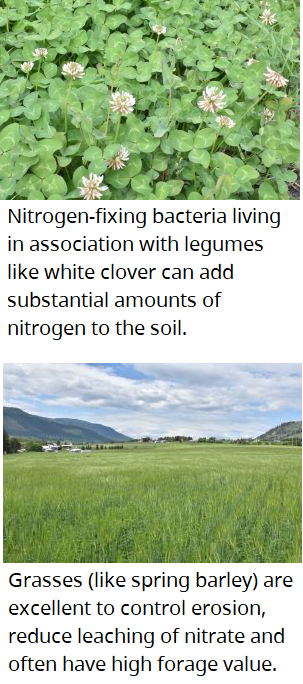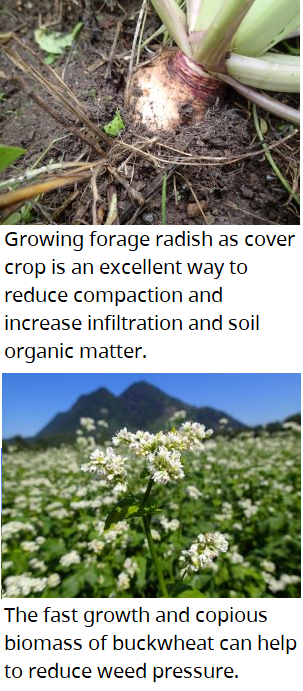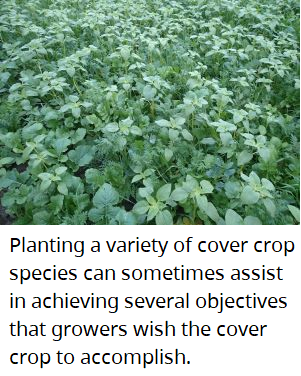Cover crops
Planting cover crops is a common farming practice with a large range of benefits for soil and operation. Cover crops can help prevent soil erosion, build soil organic matter, regulate moisture, attract pollinators, assist in weed and pest management, loosen compacted soils, and improve nutrient cycling. Unlike commercial species, cover crops are primarily grown to support a farmer’s management goals and enhance the long-term soil quality rather than for trade or human consumption.
There are three main categories of cover crops: grasses, legumes, and broadleaf non-legumes. Not all cover crop species are equally suitable for specific management objectives and each cover crop species performs differently depending on climate and soil properties.
Cover cropping resources on this webpage are:
- detailed factsheets for 23 crop species known to be grown successfully in B.C.,
- a quick reference guide (PDF 88 KB) to help narrow down cover crop selection based on plant properties and operational objectives, and
- a cover crop booklet (PDF, 4.8 MB) containing all 23 factsheets, the reference guide and an introduction with cover cropping considerations
The information provided is based on studies conducted in B.C. and the experience of B.C. farmers. It covers the major cover crop species that are well-suited to B.C. There are many more cover crop species that are or can potentially be grown in B.C. and the range of cover cropping techniques is only limited by imagination. However, available documented and vetted information on cover cropping across the diversity of climates and productions systems across the province is still sparse.
Therefore, we need your help! If you have cover cropping experience that you are willing to share, or if you would like to provide feedback on this booklet, we would love to hear from you. You can reach us by sending an email to AgriServiceBC@gov.bc.ca. Our team is looking forward to your response!
Cover cropping in B.C.
Small booklet (PDF, 4.8 MB) containing a quick reference guide and all cover crop species factsheets.
Quick reference
One-page quick reference (PDF 88 KB) to help narrow down the selection of species based on operational goals and ecological characteristics of the species.
Alsike Clover (Trifolium hybridum)
Short-lived cool season perennial with an upright to semi-upright growth habit and a taproot. Alsike clover does well in areas with high soil moisture.
Annual Ryegrass (Lolium multiflorum)
It is a rapidly growing, highly tillered cool season bunchgrass with an upright growth habit and a medium depth fibrous root. There are two subspecies grown in B.C.: Westerwold annual ryegrass and Italian ryegrass. Annual ryegrass is commonly grown as a forage crop or for rapid ground cover.
Berseem Clover (Trifolium alexandrinum)
A legume with an upright to semi-upright growth habit. Its shallow taproot causes berseem to be susceptible to drought. Berseem uses soil nitrogen in the first third of its lifecycle before supplying nitrogen in the later parts of its lifecycle. Berseem can make a high-quality animal feed when planted with oats.
Buckwheat (Fagopyrum esculentum)
Buckwheat is commonly used for attracting pollinators, weed suppression and organic matter addition on summer fallow ground. Buckwheat needs warm conditions but has little tolerance for drought or excessive heat and water-logged soils. It is known to increase availability of phosphorus for the next crop.
Common Vetch (Vicia sativa)
A legume with prostrate climbing growth habit and a medium depth fibrous root. It is commonly used for green manure and in pasture mixes. Its blue-purply flowers attract insects and pollinators.
Crimson Clover (Trifolium incarnatum)
A legume with a medium depth taproot and upright to semi-upright growth habit. Its large colourful flowers attract an array of pollinators. When compared to other clovers, crimson clover has a large seed and better seedling vigour.
Fall Rye (Secale cereale L.)
Grass with an upright growth habit and a medium depth fibrous root. Extremely winter-hardy, fall rye requires a period of prolonged cold temperature before becoming reproductive. It can tolerate low fertility, acidic and wet soils making it an excellent choice for marginal land. Fall rye begins growing quickly in the spring allowing for rapid soil coverage.
Field Peas (Pisum sativum)
A legume with prostrate climbing growth habit and medium depth taproot. Peas grow rapidly in cool conditions with adequate moisture and flower early in the season. They can be used as a cover crop, for forage or brought to harvest maturity.
Forage Radish (Raphanus sativus L.)
Also referred to as daikon or tillage radish, it has an upright growth habit. Its deep taproot is known for reducing compaction. Winterkilled plants decompose rapidly in the spring, releasing nitrogen quickly.
Hairy Vetch (Vicia villosa)
A legume with prostrate climbing growth habit with a medium depth taproot. It can be an annual or biennial. Hairy vetch has blue-purple flowers that attract insects and pollinators, if permitted to go to flowering stage. Known for its winter hardiness, hairy vetch is more cold-tolerant than common vetch. Compared to other legumes, hairy vetch can fix the highest quantity of nitrogen.
Mustard (Brassica spp.)
A blanket term for a number of brassica species such as white/yellow mustard and Indian/brown mustard. Mustards are good weed suppressors and can act as a biofumigant.
Phacelia (Phacelia tanacetifolia)
A cover crop species with an upright growth habit and deep taproot. Phacelia is often used to attract pollinators and other insects due to its long flowering period. Phacelia has a high nitrogen content causing it to breakdown quickly after being incorporated.
Red Clover (Trifolium pratense)
A legume with an upright growth habit and a deep taproot. It is a short-lived perennial legume capable of fixing ample nitrogen. In monoculture, weed suppression is limited due to the slow development of red clover. It does well when planted with cereals as it can establish without decreasing yields and increases weed suppression.
Sorghum-Sudangrass (Sorgham bicolor x Sorgham biocolor)
If given appropriate fertility, the biomass production of this grass species is substantial, with plants growing 6-12 feet tall. With its thick fibrous root systems, it can decrease compaction. Mid- season cutting has been shown to increase both yields and root penetration of the cash crop.
Spring Barley (Hordeum vulgare)
A grass species that can produce high levels of biomass. It can be used as a forage, for plow-down, or, if brought to maturity for grain. It is often used in multispecies mixes for silage and tolerates alkalinity. Spring and winter barley are the same species, but spring barley varieties are generally not as cold-tolerant and do not require a cold period to flower.
Spring Oats (Avena sativa)
A relatively inexpensive, rapidly growing cool season annual grass. It is well suited as a spring or fall cover crop alone or in a mixture with other species. Oats grow tall with better tolerance of water-saturated soils than other spring cereals.
Spring Wheat (Triticum aestivum)
A grass cover crop species capable of being used as a cover crop, forage or brought to maturity for grain. It will flower in the same year it is planted. It is an excellent nitrogen scavenger with high quality forage potential. Winter and spring wheat are the same species, but spring wheat varieties do not require cold exposure for flowering and tend to be less effective in weed suppression.
Subterranean Clover (Trifolium subterraneum, T. yanninicum, T. brachycalicynum)
This low growing legume with a deep taproot is suitable for grazing but is not suitable as hay due to its growth habit.
Subterranean clover has vigorous seedlings that form nodules quickly.
Sweetclover (Melilotus spp.)
A legume with an upright growth habit and deep taproot. It can be either an annual (white flower) or biennial (yellow flower). Its deep taproot is thought to decrease compaction and allows sweet clover to be drought tolerant once established. It can be used for grazing; however mature sweet clover has decreased palatability. White flowering sweet clover does not produce as much as the yellow flowering and is less drought-tolerant.
White Clover (Trifolium repens)
A legume with an upright growth habit. Seedlings have a taproot but as the plant matures fibrous roots develop from detached stolons. It does best on heavy soils with little drought stress and can be used as a living mulch due to its high tolerance for traffic. It tends to spread into adjacent plant rows and does not die off easily when dug under on some soils.
Winter Barley (Hordeum vulgare)
This cover crop grass species can also be used as forage or brought to maturity for grain. It can produce high levels of biomass for forage production, ground cover or plow down. It also has potential use as a spring seeded nurse crop as a component of a blend. Winter and spring barley belong to the same species, but winter barley varieties tend to produce more biomass and often require exposure to a cold period for flowering.
Winter Triticale (X Triticosecale)
A cross between wheat and rye with an upright growth habit and a medium depth fibrous root system. It must overwinter before stem elongation, flowering and grain fill can occur. It has a similar biomass, but less weed suppression potential compared to fall rye.
Winter Wheat (Triticum aestivum)
A grass species with an upright growth habit and a medium depth fibrous root system. Winter and spring wheat are the same species, but some winter wheat varieties must overwinter before stem elongation, flowering and grain fill can occur. Winter wheat species are often better weed suppressors than spring wheat species and they can provide an excellent quality forage.



AgriService BC
Have a question? Call or email and a staff person will assist you.
Telephone: 1 888 221-7141
E-mail: AgriServiceBC@gov.bc.ca
